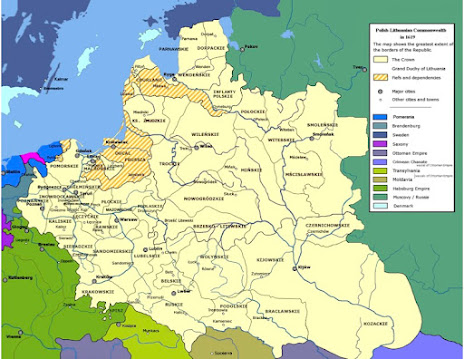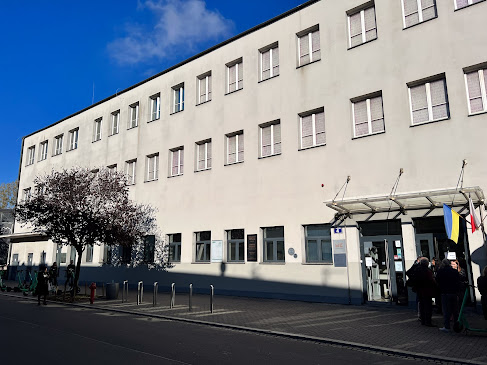As previously mentioned, Chicago, where I grew up, was a collection of ethic communities that immigrated from the nineteenth and early twentieth century. One of the major ethnic group were Polish, arriving since 1837. Every region and ethnicity in Chicago seems to have pejorative jokes about a competing group and one of Chicago's favorites were the Poles. Growing up, of course I knew nothing of their history and culture and accepted this narrative until a young man. Then, when preparing for our travels to Poland we deepened our understand of a surprisingly rich culture and tragic history.
From the sixteenth century to the eighteenth century Poland and Lithuania formed a commonwealth - in part to be economically and politically stronger against their agressive neighbors to the North (Sweden) and east (Russia). It was one of the largest monarchies in Europe; with dual heads of state.
However, by the end of the eighteenth century its stronger neighbors to the west, east and south, Prussia, Russia and Austria/Hapsburg partitioned the commonwealth among themselves. Poland ceased to exist as a sovereign nation. After WWI they obtained their independence again, however within thirty years they were taken over by their former nemesis Russia, in the form of the communist Soviet Union. Since 1989 have they struggled to throw off the oppressive bureaucracy and become a beacon of freedom and model of economic reform. Sadly, for the past decade or so they are backsliding under the Law and Justice party led by Andrzej Duda who is slowly dismantling the checks and balances of democracy. Nevertheless, they continue to be a supporter of the EU and NATO, and denounce Putin and the invasion of Ukraine.
We flew from Prague to Krakow. Krakow first came to my awareness in the movie Sophie's Choice while I was in graduate school in my late twenties. The main male character Nathan, played brilliantly by Kevin Klein, was revealed to be schizophrenic toward the end of the movie. He was incredibly devoted to Sophie, played by Meryl Streep, a survivor of the Auschwitz death camps. However, he was obsessed with the Nazi crimes and the Holocaust. In one of his crazy episodes he questions how Sophie survived the death camp shouting "Go back to Krakow baby. Back to Krakow". It was then I realized the city was central to the Nazi invasion of Poland and the Holocaust. The city is also central to the movie Shindler's List, by Spielberg. Shindler's metal works factory was in Krakow
We stayed in the Old Town, compact and delightfully preserved having be spared German bombing when they captured the country and Allied bombing during WWII liberation. It's central feature is the Market Square, arguably the most beautiful in Europe
He also explained the religious contrast between Poland and Czech Republic I previously wrote about. While Czech Rep is one of the most secular countries in Europe its next door neighbor is among the most religious - and Catholic. During the communist control of Poland, the Catholic Church became a buffer between the people and the oppressive regime, despite the governments push for secularism and imprisonment of high ranking clergy. In 1978 Karol Jozef Wojtyla was elected Pope John Paul, the first non-Italian in over 450 years, and the only slavic pope ever elected. He encouraged Poles to opposed communism and fight for their freedom. In 1980 he supported the Solidarity movement in Gdansk (to be discussed later). In 1989 communism fell after they overwhelmingly elected the Solidarity Union party as the government, and Russia declined to intervene. For Poles his support for their freedom and their history of Catholicism kept them steadfast in the faith.
Our guide Tomas was so enthralling with his stories that when we heard he was giving an evening tour of the Jewish Ghetto we immediately signed up.
When walking around the square we went into the local bookstore and met the very old and very engaging jewish owner. He recommended several books, but we were traveling. However we purchased one, the true story written by Jan Karski called "Story of a Secret State - my report to the world". His story as part of the resistance and a spy. He personally related the atrocities to Roosevelt and Churchill. Well worth the brief read.
Tomas was able to bring to life (and sadly the death) of Krakow's WWII history and the systematic murder of the Jewish population. One of the more memorable stories was of a six year old Jewish boy forced into the Ghetto. His mother was taken (and eventually died in the death camps) and his father was distraught. Seeing the Germans coming the little boy grabbed his fathers hand and led him across a bridge to safety in the Ghetto. The little boy was Roman Polanski. I'll mention him again in Warsaw.
The other story he related with more frustration is the number of German businesses that supported the Nazi, and are still in business today. Some used human hair, "unquestioning" its source, to weave fabrics or blankets for the army. When watching WWII movies/documentaries I have always marveled at the SS and Nazi uniforms which were, from a fashion standpoint, beautiful. It was clarified when Tomas explained that Hugo Boss was the designer for the regime, and the company is now a leader in Haute Couture fashions.
The following day we took a day trip to Auschwitz. There has probably been enough written about the horrors there, and further description will not duplicate a personal visit there. But some images may convey some of the sadness and atrocities.
Our final day in Krakow we revisited some of our favorite places in Old Town and in the Jewish Ghetto. Both of us enjoyed Krakow more than Prague. While Prague is a lovely city with lots of history and things to do and see, it felt like an outdoor museum as times, similar to Venice, Florence, or other over touristed and well preserved cities. Krakow felt real. There is a sizable youth population and the bars and restaurants around the Ghetto were hopping with locals rather than tourists.
Our last city in the south was Warsaw. There's really not much of interest here. If reminds one of modern Frankfurt with a dabbling of Soviet buildings (if you're familiar with Moscows Seven Sisters of Stalinist times).
Their Old Town, or Old Warsaw, was completely destroyed during WWII. Post war, it was the first attempt to completely rebuild a historic city core and was designated a UNESCO World Heritage site in 1980. To get a sense of the complete destruction of the city see Polanski's The Pianist, with Adrian Brody.
Next Post: Poland Part 2 - Gdansk

































Nice write up Bill! Thanks for sharing.
ReplyDeleteGreat commentary, Bill. The pictures come alive with your reflections.
ReplyDelete